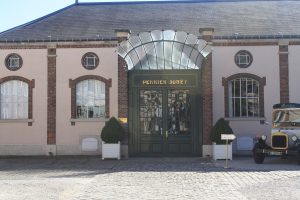According to World Food and Wine, there are 19,000 (!) vineyards growing grapes to be used in Champagne wine. Of these, 2,124 make and sell the wine itself. Of course, the majority are small producers that are barely known outside their villages. But there are 260 large producers, the top 76 of which are known as the Grandes Marques & Maisons, in other words the biggest players in the market. These latter houses make two-thirds of the Champagne sold in the world and 90% of those exported from France.
Perrier-Jouët headquarters in Épernay
You surely know some of the Grandes Marques, such as Moët & Chandon, Perrier-Jouët or Taittinger. But have you heard of, let alone tasted, such labels as Canard-Duchêne, Mansard Baillet or Charles Mignon? These last three are also considered among the “big houses”. And we at Power Tasting can assure you that there are many other smaller Champagne houses that make extremely high-quality wines. They just don’t ship very much outside of France and even less that reaches North America.
Of course, with that many to choose from, no sane wine tasting visitor can hope to try them all. Moreover, each house is likely to have a selection to choose among. Almost all will have an Assemblage, made from the three Champagne grapes: Chardonnay, Pinot Noir and Pinot Meunier. Then there will be a Blanc de Blanc made from Chardonnay only and, so we are told, most connoisseurs prize the BdB most highly. Maybe we’re not connoisseurs, because we often favor a Blanc de Noir, made from red grapes, usually Pinot Noir. Oh, yes, and then there’s the Champagne rosé as well. And then each Champagne house has its top wines (known as the tête du cuvée) that you really want to try if you’ve travelled all that way to taste Champagne. But don’t expect to taste too many houses’ Champagne in any one day.
There are local people and Champagne specialists who can differentiate wines from different sectors of the Champagne region. It’s no different than being able to taste the differences between, say, a Stags Leap Cabernet Sauvignon and one from Calistoga. (Quite frankly, we can’t do either one.) But it is interesting, though not surprising, to see that the white grapes come from one part of the region and the reds from another.
The one thing that does makes true Champagne distinct from all other sparkling wines is the chalk just below the soil. The caves where they age the Champagne are also made of chalk. The controversy over terroir vs. winemaking skill will never end, but there is no doubt that the soil in this part of France makes Champagne different – and we would say better – than bubbly from anywhere else.

Of course there’s no shortage of winemaking skill in Champagne. Some of the credit that goes to Dom Perignon may be apocryphal, but there is no question that a few centuries of making these marvelous wines do develop a certain proficiency. And it is a very interesting exercise to taste a few different Champagnes, available by the glass, made by the winemakers from various houses. This kind of tasty test raises the level of your understanding of the subtleties that go into making Champagne.
